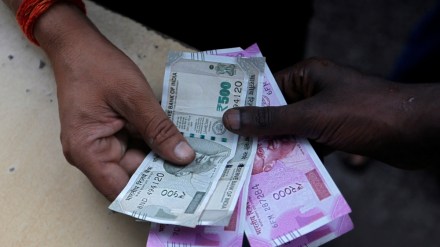At a time, when transactions through Unified Payment Interface or UPI are growing at a tremendous clip of 40%, the demand for cash hasn’t gone down at all. In fact, the value of transactions is on the rise.
A recent report by CMS Info Systems — which provides logistics and technology solutions to banks, among others — said that the monthly average cash withdrawals from automated teller machines (ATMs) rose about 6% year-on-year (YoY) in FY24 to Rs 1.43 crore per ATM, from Rs 1.35 crore in FY23.
On a monthly basis, the average ATM cash withdrawals in FY24 were higher compared to FY23, with withdrawals in 10 out of 12 months exceeding the FY23 monthly average of 7.23%.From a longer four year perspective, cash withdrawal from ATMs rose from Rs 28.78 trillion in FY21 to Rs 32.42 trillion in FY24, according to Reserve Bank of India (RBI) data compiled by FE. The overall number of ATMs and cash recycling machines (CRMs) on branch site and off-site have also risen from 2.10 lakh in FY20 to 2.18 lakh in FY24. The micro-ATMs, meanwhile, have grown exponentially from 5.43 lakh in FY21 to 17.55 lakh in FY24.
Higher cash withdrawals come at a time when the regulator is promoting higher adoption of newer payment technology like Unified Payments Interface (UPI). UPI transactions in volume terms rose 50% YoY to 13.3 billion in April, 2024, and transaction value also rose 40% YoY to Rs 19.6 trillion.
What makes cash tick, still?
According to Anush Raghavan, President, Cash Management Solutions, CMS Info Systems, even in large and developed economies, people continue to actively prefer cash usage due to factors such as risk with digital payments, control spending behaviour and non-inclusion of vulnerable consumer groups.
“As a physical payment mechanism, cash strongly demonstrates its ‘store of value’ and ‘bridges trust in a transaction’ with consumers globally, which cannot be fulfilled by any other digital payments. For an economy to flourish, it is imperative that the payments ecosystem allows all modes of transactions,” he said.
Sandeep Ghosh, group country manager, India and South Asia, Visa, said around 60% of personal consumption in India is still cash. Digital has grown remarkably but till cash consumption falls, the total amount of cash in the system will continue to grow albeit not at the same pace. ý
K Srinivas, MD & CEO at India1 Payments—white label ATM major—said there are roughly about 300 million people who use UPI, however, India has close to a billion bank accounts. This means that 700 million people still do not use UPI, and even amongst 300 million who do use UPI, 100% of user transactions are not done digitally.
“The fact is that out of 300 million UPI users, top 30%-35% users account for 90% of transactions. Therefore, many UPI users use digital and cash services both. Therefore value of cash growing is not surprising at all. Digital and physical cash transactions will continue for a long time,” he says.
Srinivas says India’s nominal GDP is growing by 9%-10% and therefore cash will continue to grow at the similar pace going ahead. Even if UPI eats into “little bit” of cash transactions, the overall cash transactions will go up, he says.
“We run about 13,000 ATM and have seen transactions growing. The average ticket size per cash withdrawal transactions is also growing by 3% YoY. This is a healthy trend where both growth in cash and UPI are happening simultaneously,” he said. A payments bank official said cash transactions are also high due to lack of implementation of UPI ecosystem in agriculture and food supply chain, which engages large volumes of farmers and traders.
Parag Rao, country head of payments, liabilities, among others at HDFC Bank, said gradually, at “some point of time”, the growth rate of cash transactions will slow down. “We have seen that as the economy is growing and consumption is high, cash has also gone up in a similar proportion albeit slower than digital transactions,” he said.
